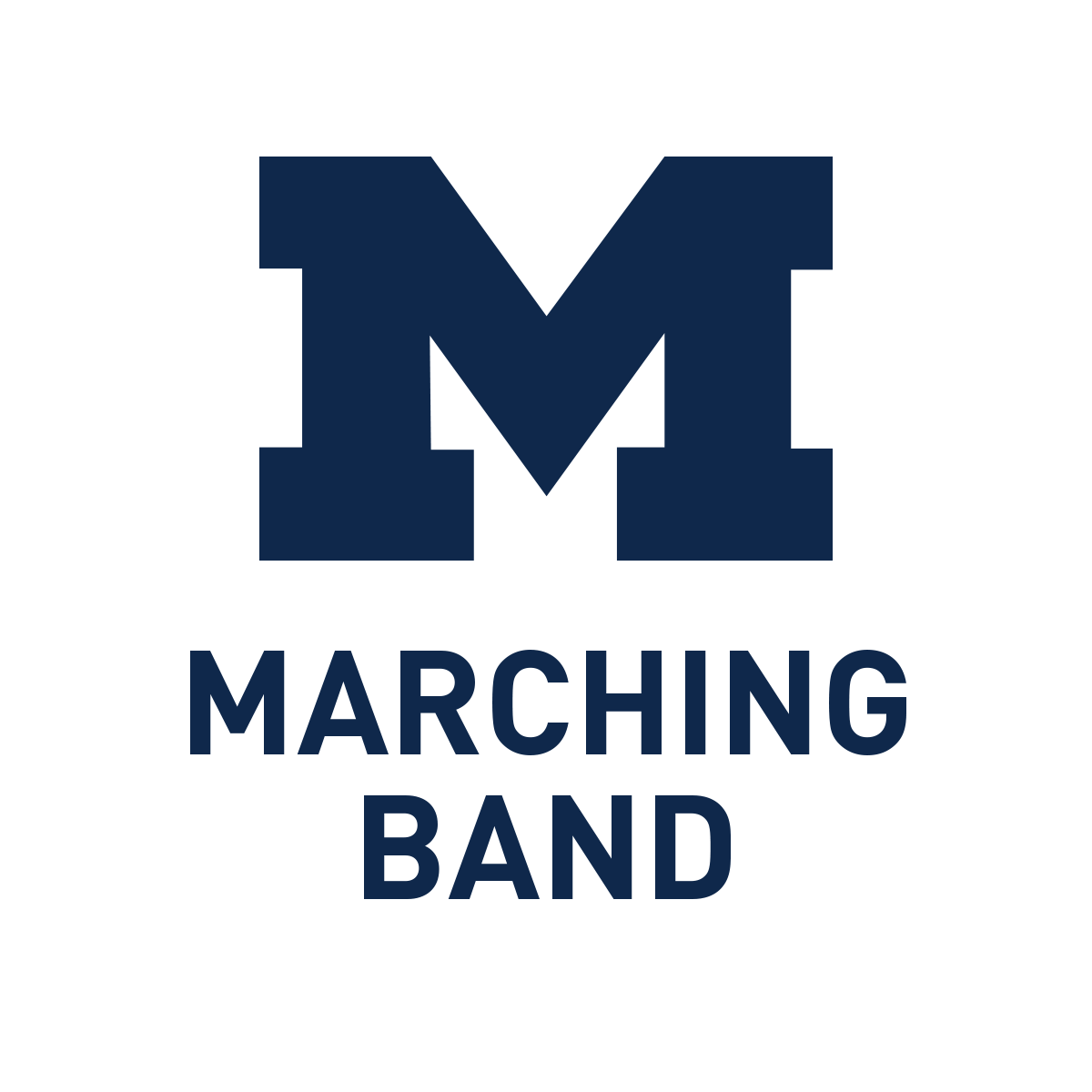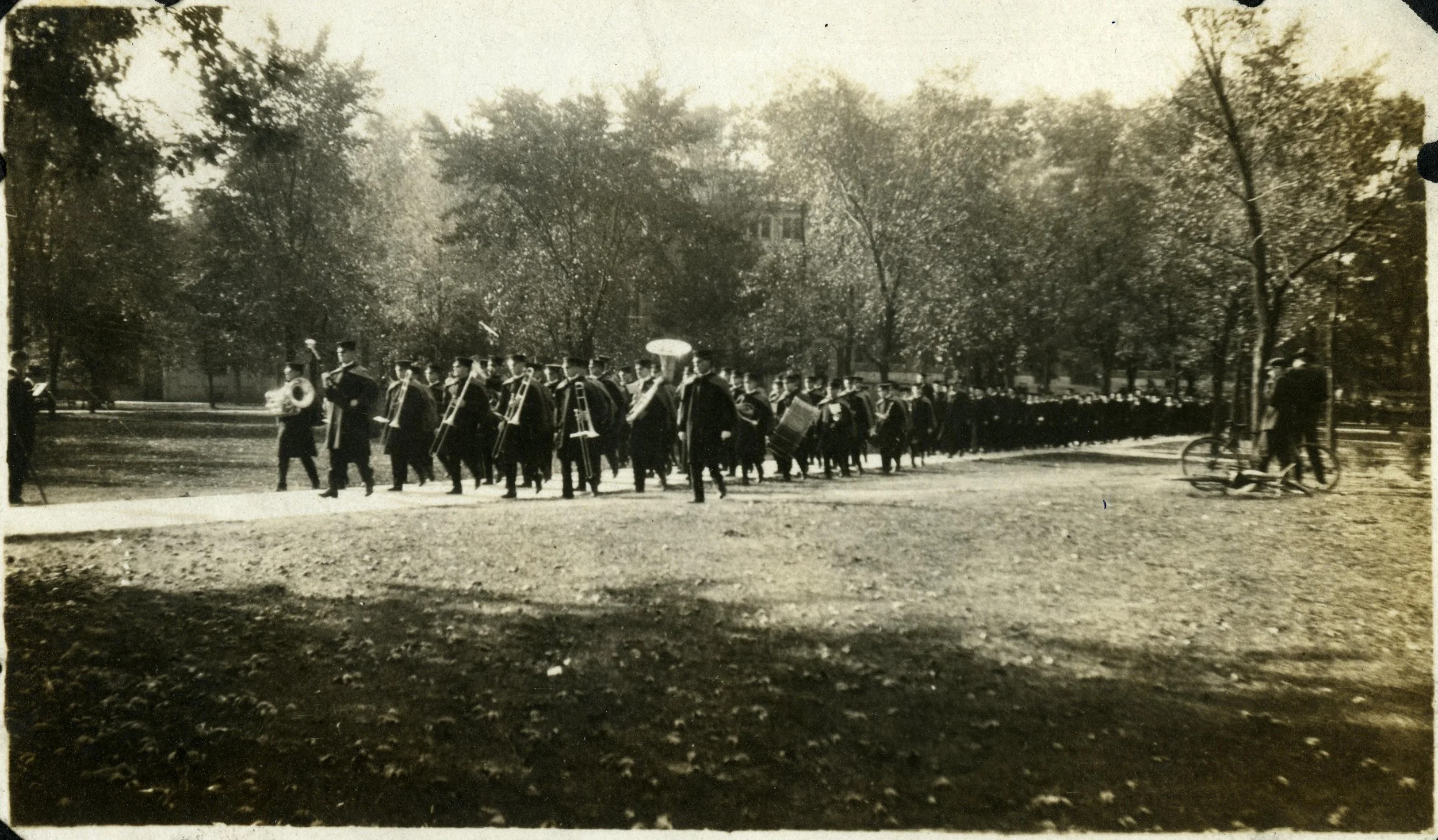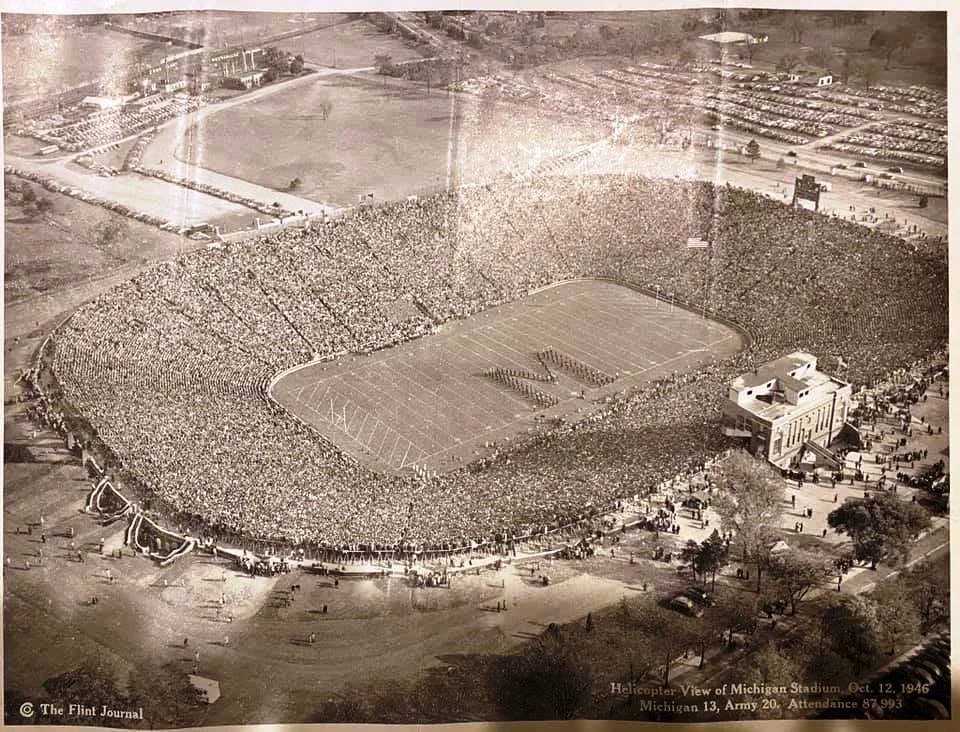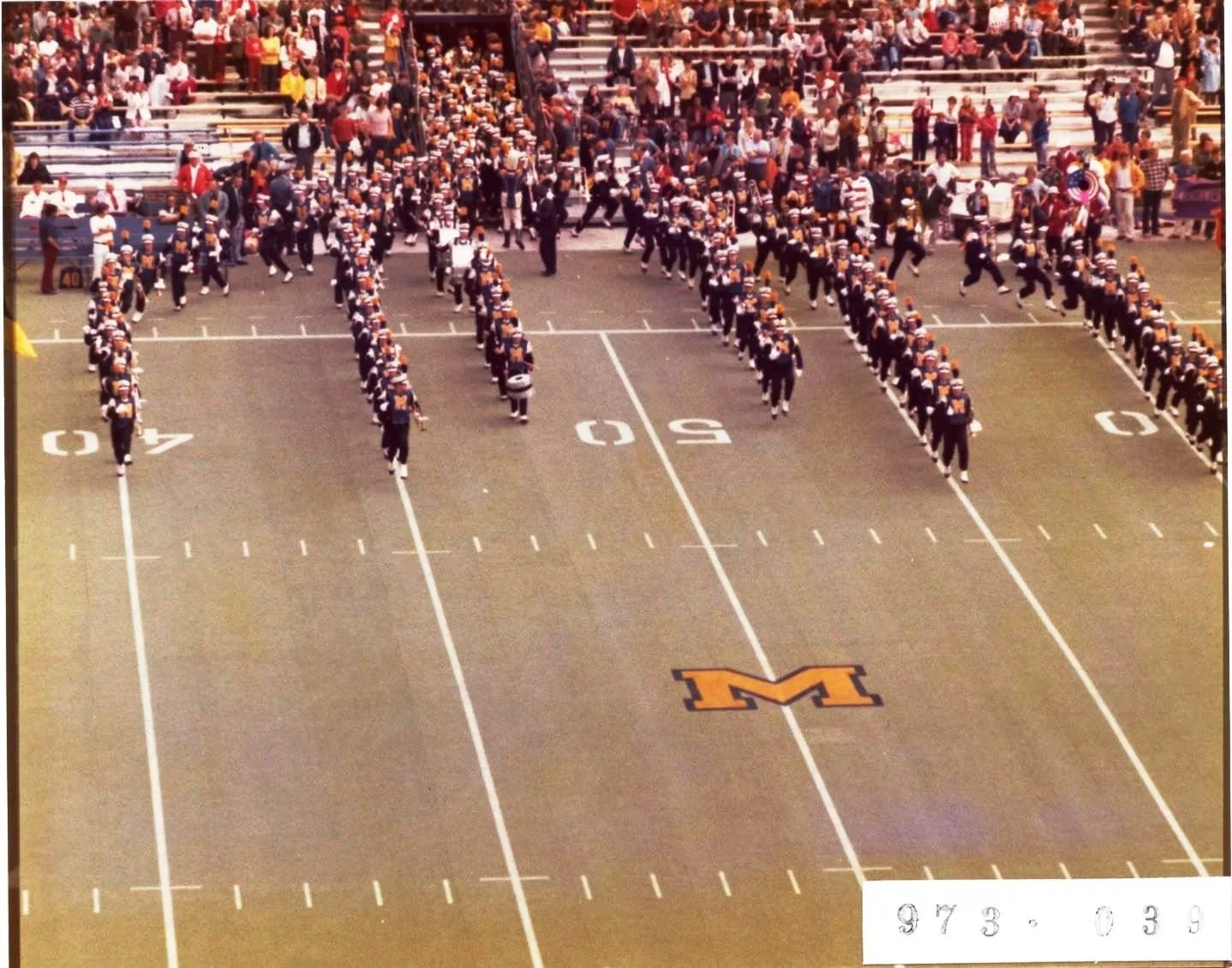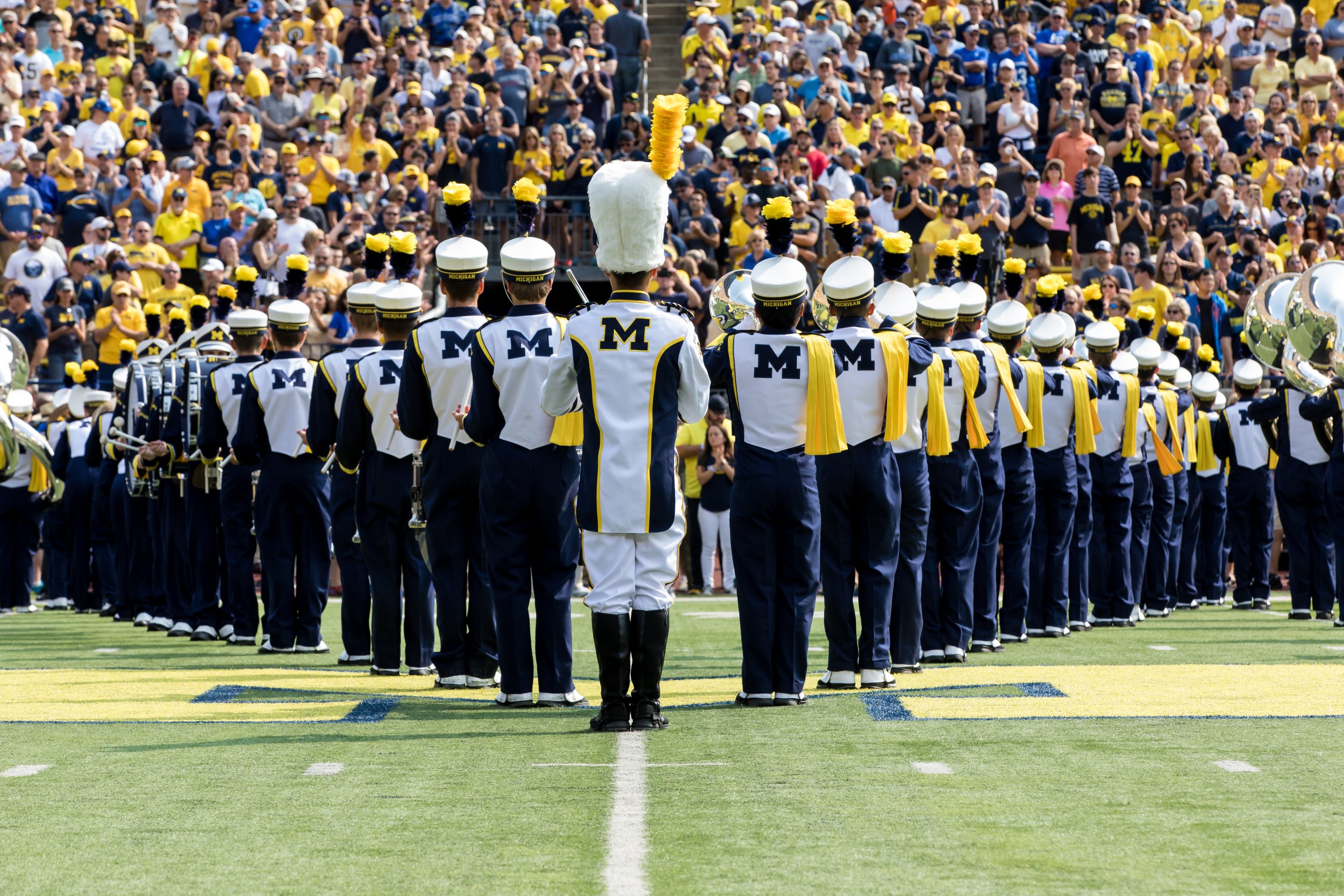
In the finest tradition of 19th-century Americana, the origin of the Michigan Marching Band was a grassroots student effort. In November 1896, the University of Michigan Band held its first rehearsal.
At the behest of University President James Burrill Angell that the newly-formed band prove itself to be a "sincere venture," the U-M Band gave its first public performance in 1897 at old University Hall for the Law School's annual observance of Washington's birthday. The first appearance on a football field was in the fall of 1898.
Directors of University Bands
Jason Fettig (2024 — present)
Michael Haithcock (2001–2023)
H. Robert Reynolds (1975–2001)
George R. Cavender (1972–1975)
William D. Revelli (1935–1971)
Nicolas Falcone (1927–1934)
Captain Wilfred Wilson (1915–1926)
Eugene "Ike" Fisher (1906–1914)
DIRECTORS OF THE MICHIGAN MARCHING BAND
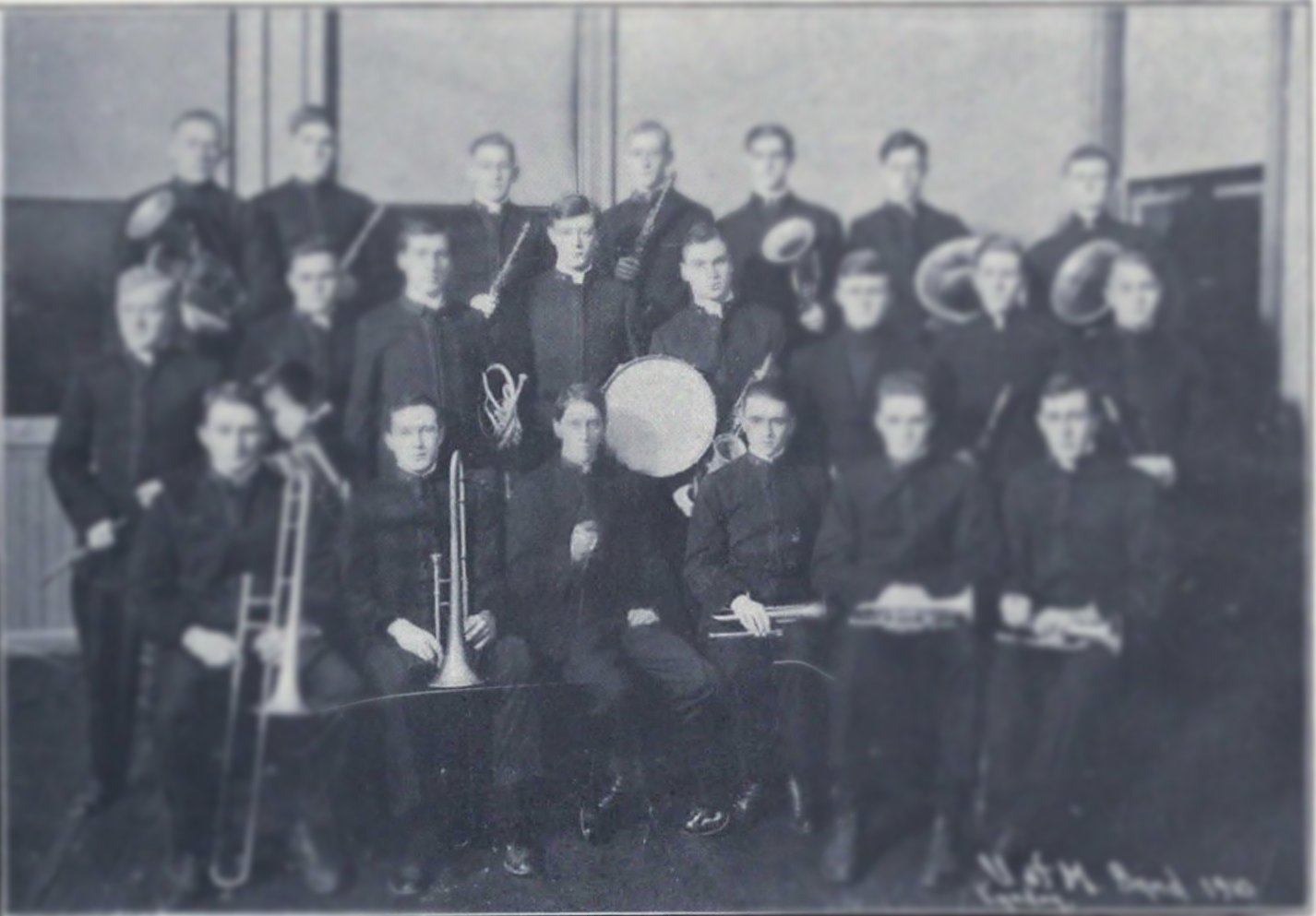
Eugene "Ike" Fischer (1906-1914)
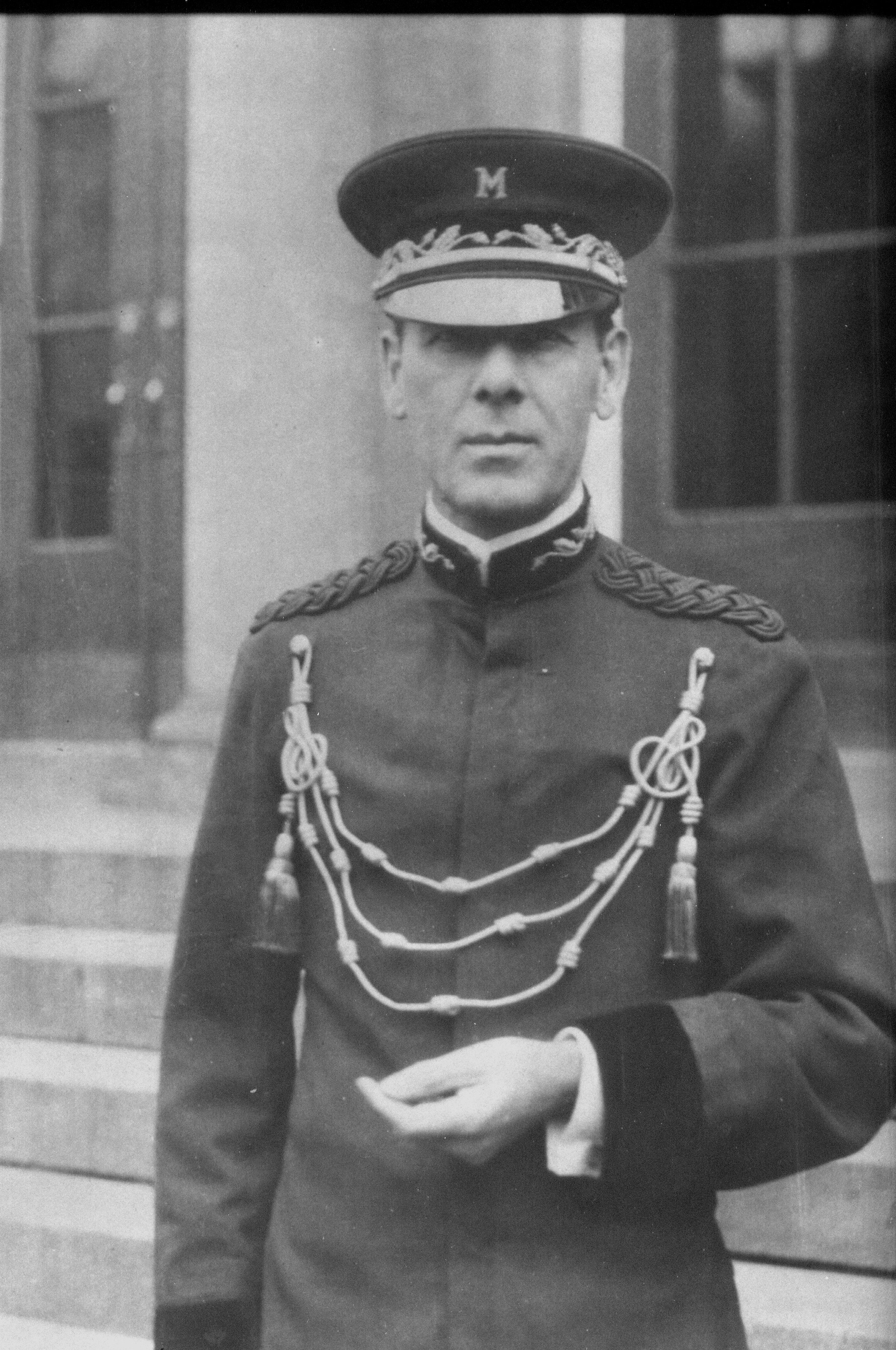
Captain Wilfred Wilson (1915-1926)
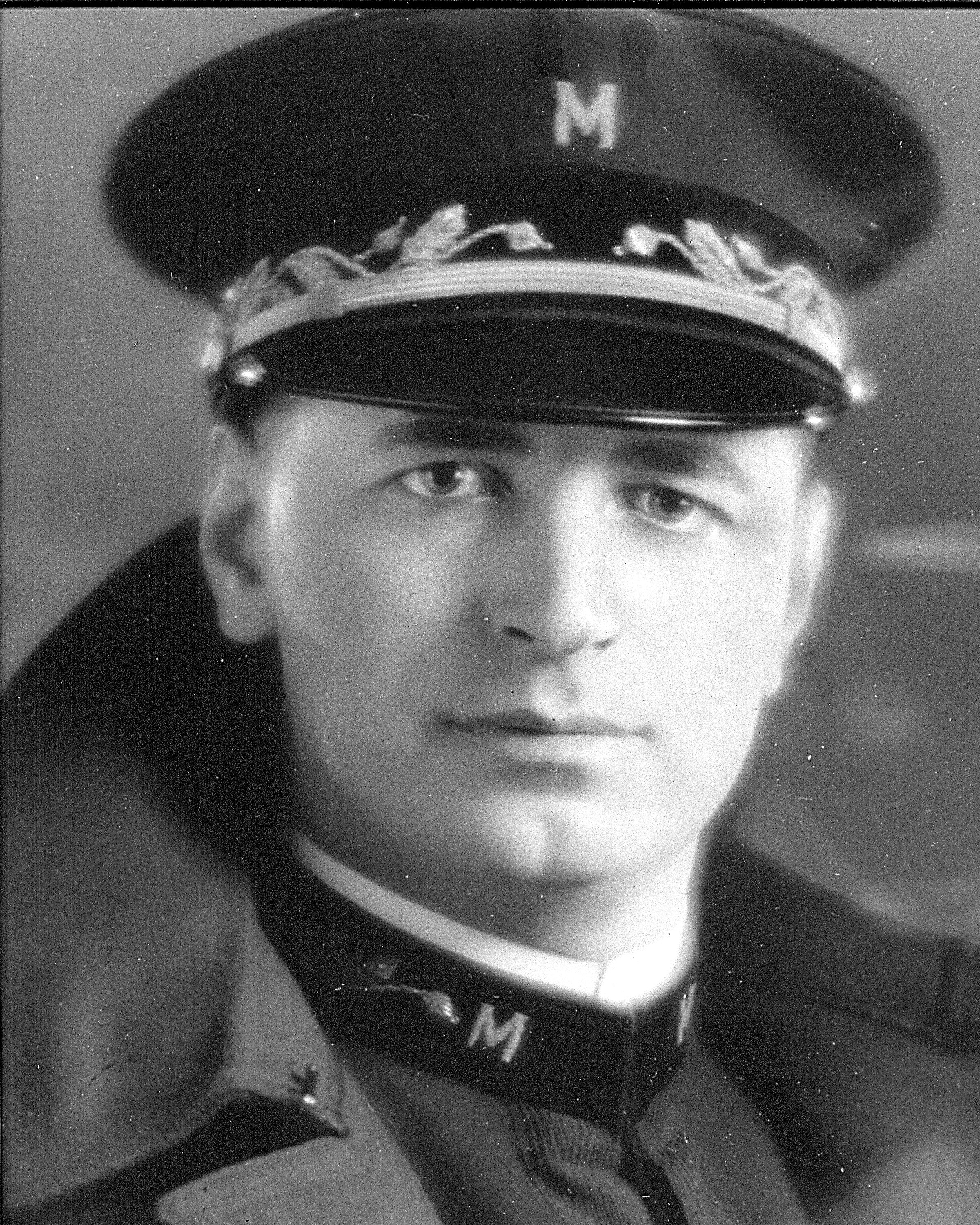
Nicholas Falcone (1927-1934)
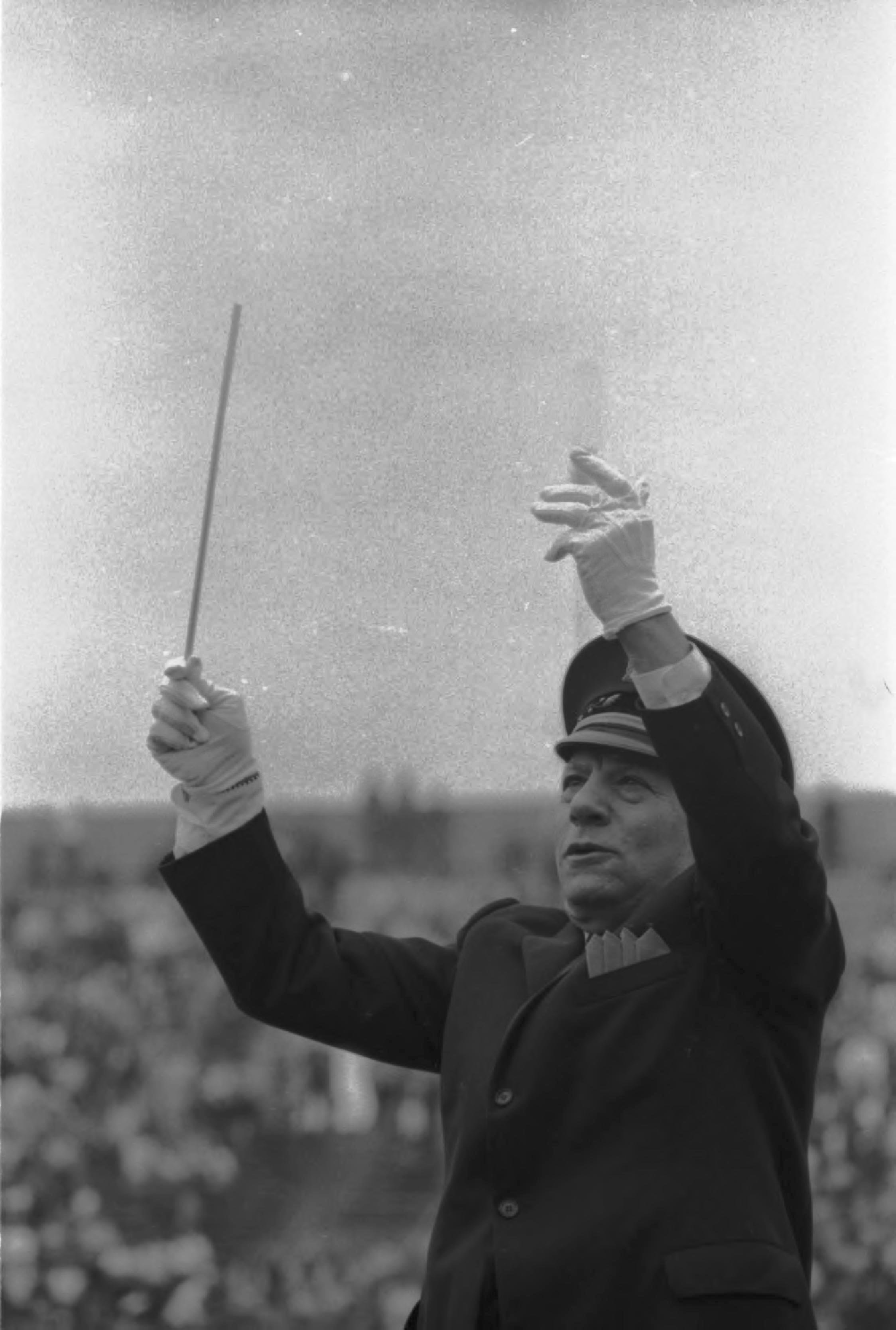
William D. Revelli (1935-1971)
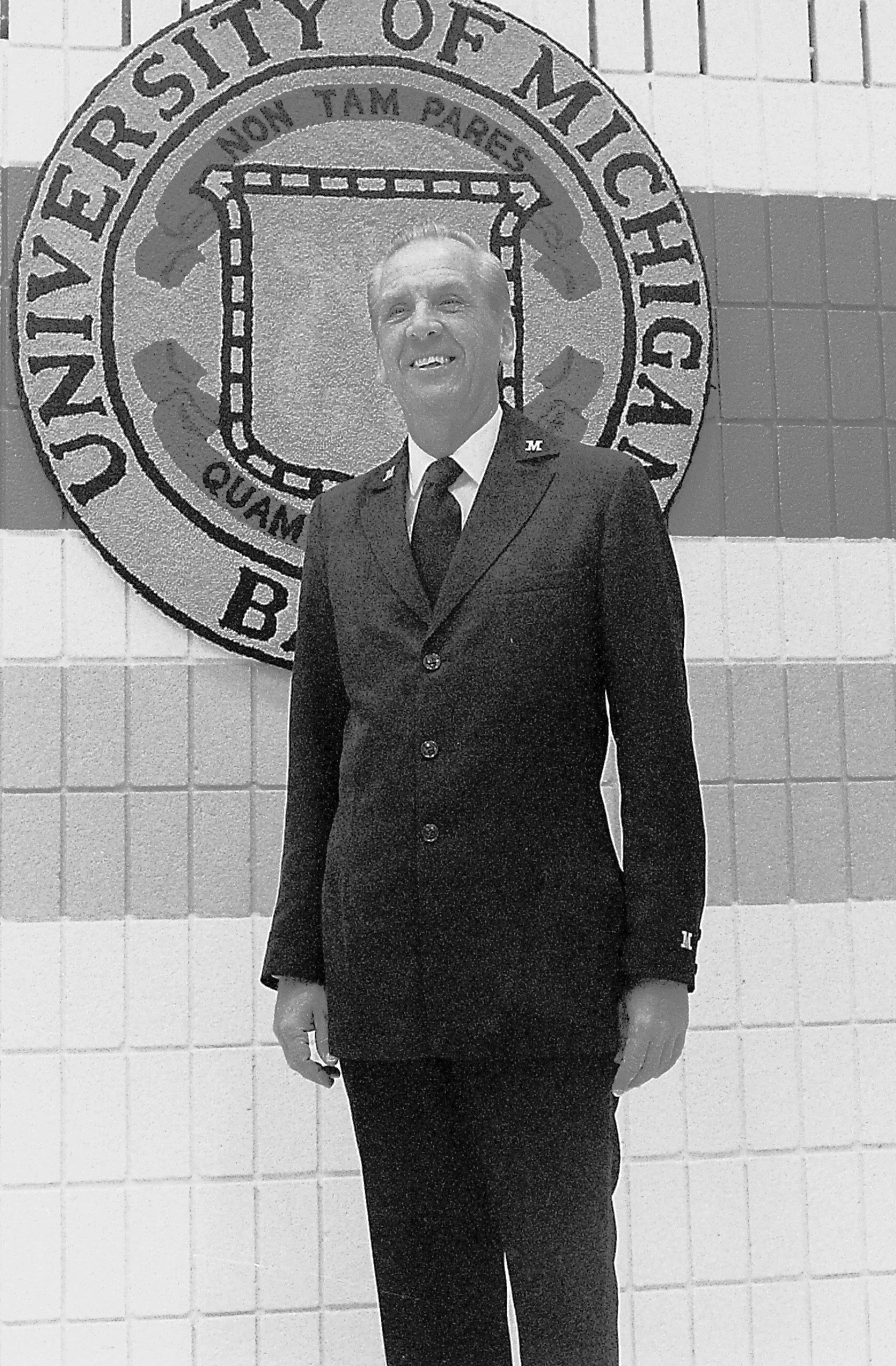
George R. Cavender (1971-1979)

Glenn Richter (1979-1980)
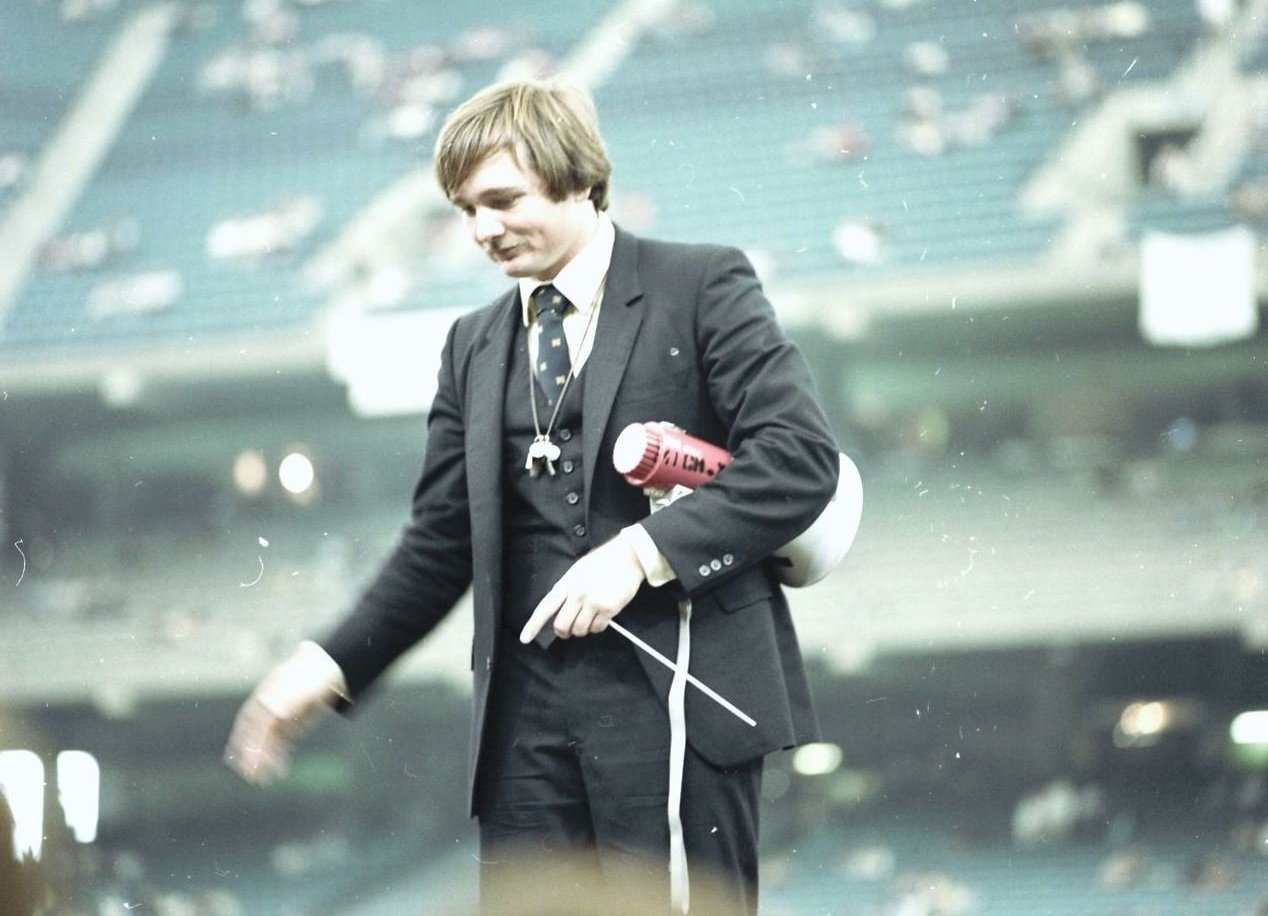
Eric A. Becher (1980-1989)
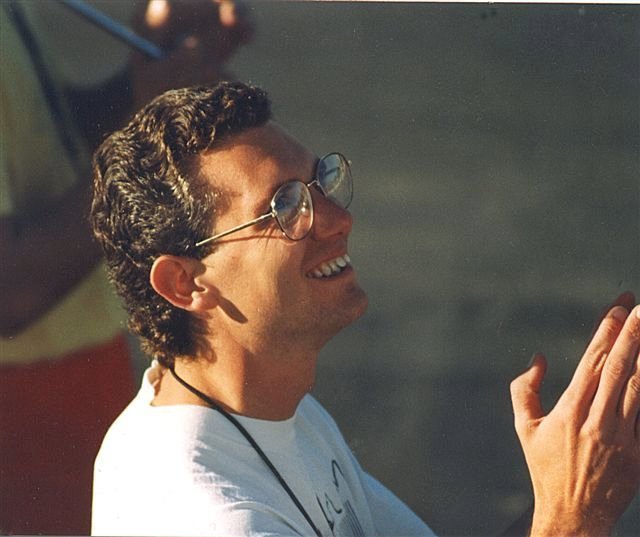
Jerry Luckhardt (1989-1990)
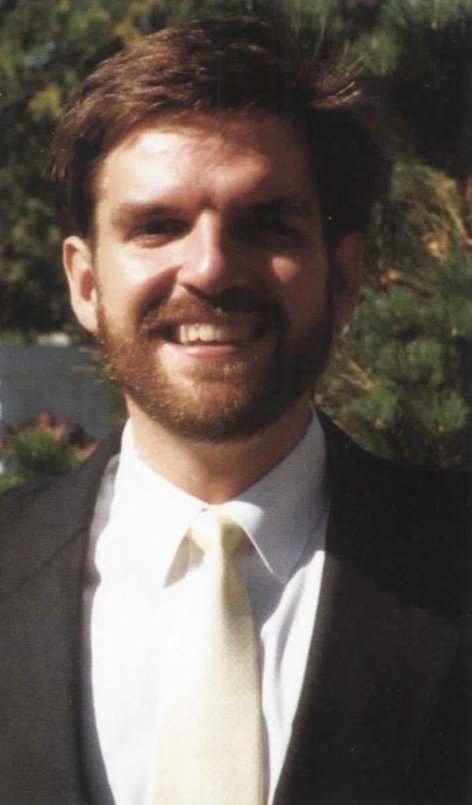
Gary J. Lewis (1990-1995)
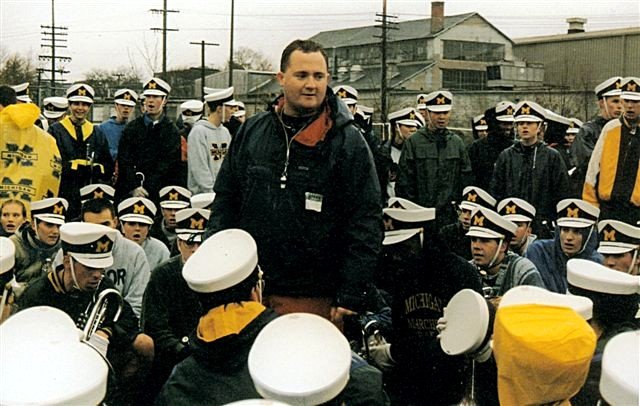
Jeff Grogan (1995-1996)
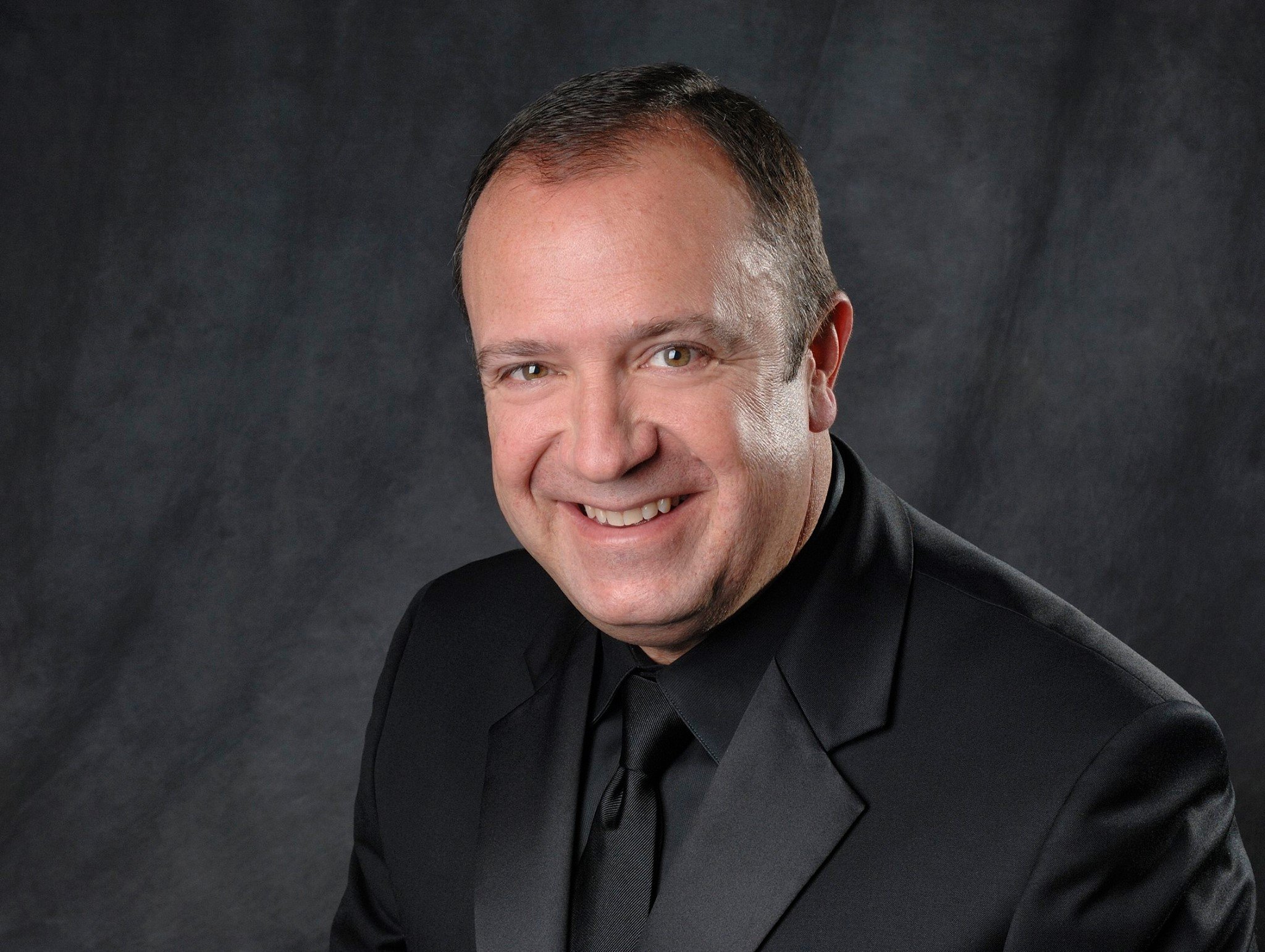
Kevin L. Sedatole (1996-1999)
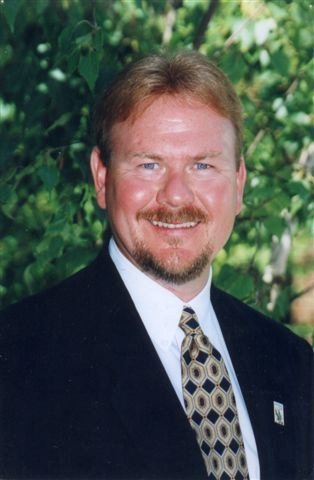
James R. Tapia (1999-2001)

Jamie L. Nix (2001-2006)
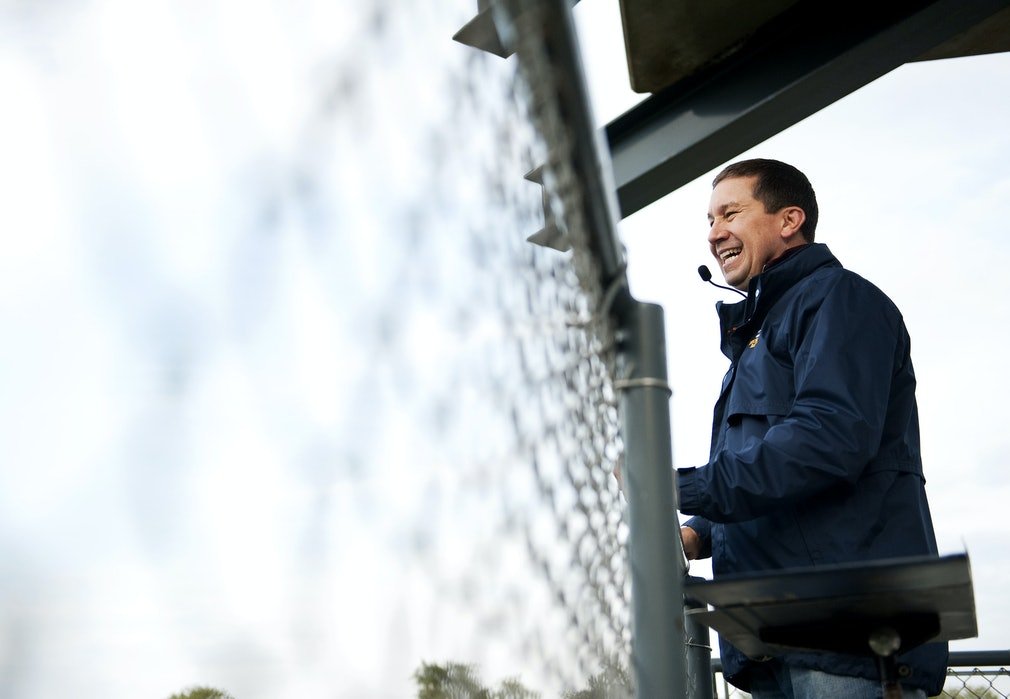
Scott Boerma (2007-2012)
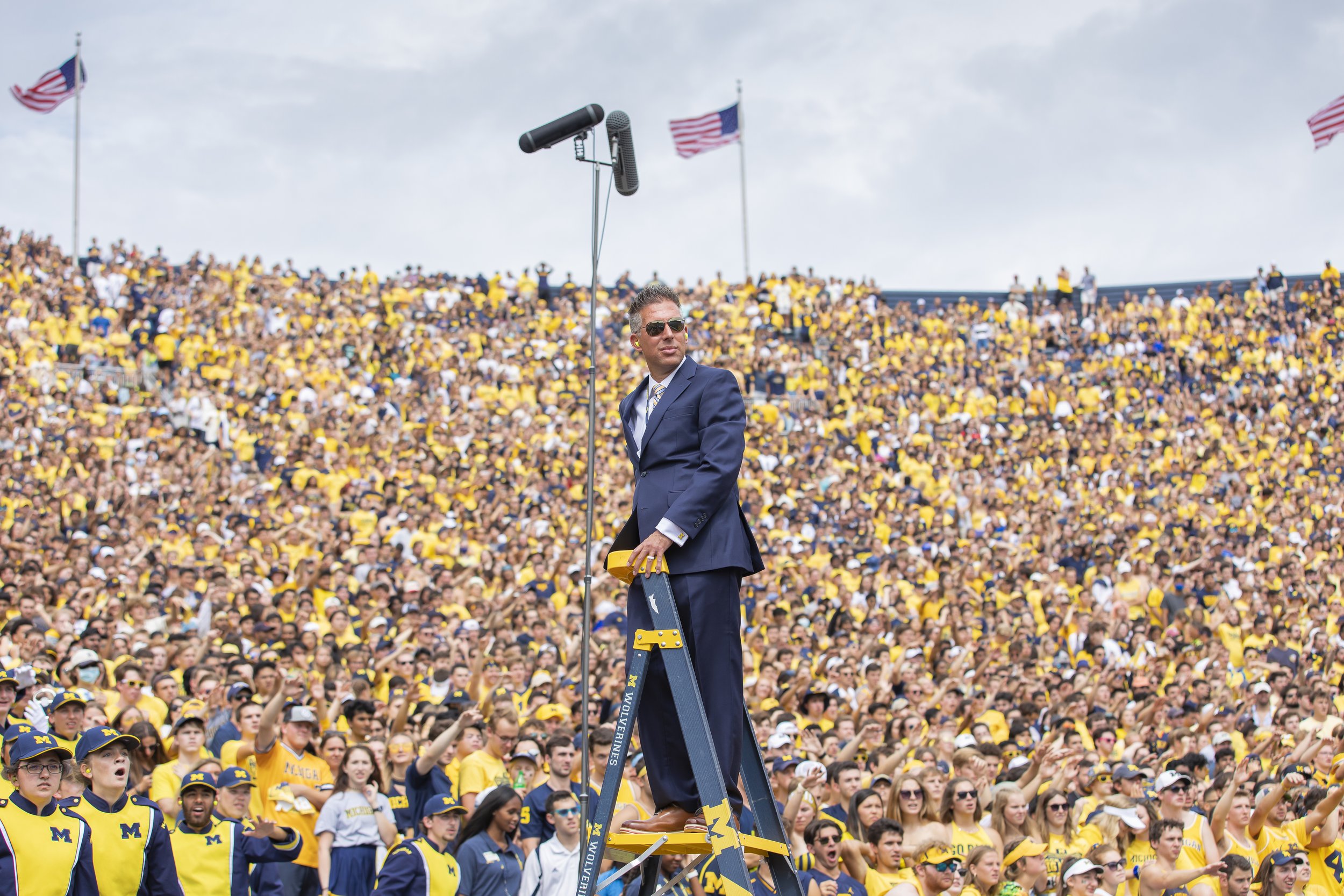
John D. Pasquale (2013-Present)
ORIGINS OF THE MICHIGAN BAND
"A SINCERE VENTURE"
The history of the Michigan band began in the fall of 1896 when a seventeen-year-old lad from Ann Arbor, Harry dePont, invited all musicians on campus to attend a meeting for the purpose of organizing a band for the University. The idea of a University band was not a new one -- in previous years, there had been several attempts to start up a band. All of these endeavors had failed due to a lack of support. To dePont's delight, nearly thirty musicians gathered in Harris Hall on November 13, 1896, for an initial meeting where Ray P. Warren was elected the conductor. Warren, a talented cornetist, was a vocal student at the Ann Arbor School of Music, a private institution run by the University Musical Society at the time.
An entirely student-run organization, the band received no support from the University, and the biggest problem confronting the members of the band was that they had no place of their own to rehearse. In search of a suitable home for the band, dePont decided to go to the University's venerable president -- and close family friend -- James Burrill Angell for assistance. Harry boldly entered President Angell's office and requested that the University provide a rehearsal site for the band. Angell replied, "I shall be very glad to assist the band, but you must show me that this is a sincere venture." It was a safe answer; the president, after all, was a cautious man. In response, dePont assured Angell that the band was prepared to provide music for the Law School's annual observance of Washington's Birthday -- one of the most important events of the school year. On the twenty-second of February, 1897, the band performed on the stage of University Hall, and in dePont's opinion, the band's performance was "a hit." President Angell granted permission for the band to rehearse in Room A of University Hall. Unfortunately, the thin walls were not soundproof and the band was forced out of the Hall and into the fencing room at Waterman Gymnasium.
By spring, the band had established itself as one of the most popular groups on campus as it played at all the indoor track meets and baseball games. It was at one of those track meets that Louis Elbel, a sophomore, tied the world record for the 40-yard dash. During Commencement Week that spring, the band played at the social event of the year -- the Evening Promenade. As the academic year came to an end, the Michigan Alumnus magazine praised the University of Michigan Band -- "a new organization this year" -- and hoped that it would be continued.
ON THE FIELD
The fall of 1897 found the University Band beginning its second year with a new leader, Lewellyn L. Renwick, who was the instructor of organ at the School of Music. On October 7, 1897, the band announced that formal uniforms were "still a thing of the future." For the first rehearsal, the thirty-five members were reminded to bring their own instruments and music racks. With only a few days of practice, the band was present at the first campus Mass Meeting of the new football season and played "several lively two-steps which brought hearty applause and started the enthusiasm." The Michigan Alumnus noted that the band played at all "the big football games and mass meetings." Wearing blue serge coats, white duck pants, and "M" caps that were purchased the previous spring, the twenty-five-member University band accompanied the football team to Detroit on November 13 for the game with Minnesota that Michigan won 14-0.
By the fall of 1898, the presence of the band at the football games had become an indispensable part of the Michigan football tradition. After Michigan's season-ending come from behind victory against the University of Chicago, a post-game celebration began in the streets of Chicago. Leading the festivity was the University of Michigan Band. Among the revelers was Louis Elbel who thought that the band "didn't have the right celebration song." Later, Elbel claimed to have heard a band "singing" a tune in his head which he described as a "victory song." At that moment, the refrain of what was to become The Victors March came to him. Thus, partly because of the University Band, Michigan received its great fight song.
The Early 1900s
HOFFMAN'S LEADERSHIP
During the fall of 1900, a new leader took charge of the band -- Allen Lynn Darr, a student in the Department of Literature, Science, and the Arts. Previously, Darr had played solo cornet in the Michigan Band and also served as the band's president. Beset with financial problems and internal personality conflicts, the winter of 1903 saw the temporary break up of the band. The following fall, it was announced that William Hoffman would serve as the band's new conductor. After one week of rehearsal under Hoffman's guidance, it was noted that the band's performance at the October 10 game showed "marked improvement."
It was under Hoffman's leadership that the Michigan Band made a dramatic change in its performance practice at the football games. On November 14, 1903, at the Michigan-Wisconsin game before a crowd of 10,000 people at Regents Field, the Michigan Band made a surprise entry onto the gridiron which was "greeted by a loud burst of applause." During the 1903 season, the band continued to play at the weekly Friday night Mass Meetings in University Hall where it often combined with the sound of the pipes from the mighty Frieze Memorial Organ to give loud, but spirited, renditions of The Yellow and Blue. At the last game of the season -- the annual Thanksgiving Day clash with the University of Chicago -- the Michigan Band experienced its first "snow bowl" as it bravely attempted to play and march in near blizzard conditions. In January, Hoffman resigned his post at the School of Music and left Ann Arbor to assume the position of concertmaster in Walter Damrosch's orchestra in New York City. Taking over leadership of the band was August Schmidt, the band's solo clarinetist and native of Morgantown, West Virginia.
STRUGGLING TO SURVIVE
The fall of 1904 was the fourth season of Fielding Harris Yost's long reign as head coach of the University of Michigan football team. It was a fabulous season as, once again, the Wolverines overwhelmed all opponents scoring 567 points and allowing only 22. On the October 18 game of that season against Kalamazoo, August Schmidt and the University band reintroduced a song that had not been played at a Michigan football game since the 1899 season. The song was The Victors.
For the next two decades, the band -- truly a grassroots student organization -- struggled to survive. During the fall, it was not unusual to find members of the band on the streets of Ann Arbor "passing the bucket" in an effort to raise necessary funds for the band. With no official University support and no means of financial security, its year-to-year existence depended solely on the generosity of the campus community and on the savvy of the band's conductors. With the autumn of 1906, the University of Michigan Band began its second decade of existence, and there was hope that its new, young conductor, Eugene J. Fischer, would be able to find a solution to the band's financial problems.
The Eugene Fischer Years: 1906–1914
Eugene Fischer -- better known as "Ike" -- was a student at the University when he assumed control of the band. As director of the band, he brought insight to the job that was unique, and for this reason, he had a special appreciation of both the problems and potential of the band. While financial problems could not be solved right away, Fischer was able to solve the musical challenges, and the results were lauded by the Daily which said that the band was "the best the University has had in years."
VARSITY IS BORN
During the fall of 1911, two Michigan students -- J. Fred Lawton and Earl Vincent Moore -- decided that the University needed a new song. (Since Michigan was no longer a member of the Western Football Conference, the words "...champions of the West..." as sung in the Victors seemed inappropriate.) Together, they wrote the fight song, Varsity, which was an immediate hit at the weekly Friday night pep rally in University Hall at which Moore played his new song on the Frieze Memorial Organ. Fischer was in attendance that night and, upon hearing Varsity, recognized its appeal. He agreed to play the march the next day at the Michigan-Case football game.
MICHIGAN'S FIRST DRUM MAJOR
In the fall of 1914, the band's reputation was enhanced by a new addition to its "tradition" -- a drum major. While the band occasionally had drum majors in the past, the position was not a continuing one and did not have much importance. All that changed with the advent of a sixteen-year-old saxophone player from Portland, Oregon named George Olsen. Fischer learned of Olsen's background as a graduate of a high school military school and leader of drum and bugle bands. Quickly, Olsen was named Drum Major of the University of Michigan Band.
Under Olsen, the Michigan Band first began learning precision military drill. The "new" look of the University of Michigan Band had a startling effect on the crowds. At first, there was laughter, but then people seemed to like what they saw. With the help of the faculty manager of the band, Samuel Hoexter, Olsen obtained make-shift uniforms of "canvas puttees and caps, similar to what the streetcar conductors wore." For coats, Olsen and Hoexter found some coats "from an old German Band" with braiding on them.
Olsen drilled the band every night he possibly could, and Hoexter worked "with every professor on the campus to make things easy for the boys." The following Saturday, at the game with Syracuse, the Michigan Band proudly marched onto Ferry Field, and when the crowd saw Olsen, twirling his baton in ways that had never been done before in Ann Arbor, it stood and cheered. At this, Olsen became so excited that he threw the baton over the crossbar of the goal post, and "luckily," he was able to catch it on the other side! The crowd, which assumed that this stunt was a planned part of the show, was thrilled. Since then, the goal post toss has become part of the drum major tradition during the Michigan Band's pregame.
The University of Michigan band under Eugene Fischer's direction aroused a genuine source of pride among the students, faculty, and alumni. In the spring of 1914, Fischer left the band to pursue a career as a dance band leader. During his years as director, he received little or no remuneration for his services as director of the University band. Thanks to the eloquence, persistence, and vision of Eugene Fischer, the idea that the University should control and financially support the band was firmly in place. In 1913, the Board of Regents agreed in theory to the plan which Fischer had advocated for so long. Adequate funding for the band was assured; a first-class conductor would be hired. While the details of the plan were still being worked out between the Regents and Samuel Hoexter, the band during the 1914-15 school year was led by Herbert Richards.
The Wilfred Wilson Years: 1915-1926
In the summer of 1915, it was announced that the University had hired Wilfred Wilson to serve as the conductor of the University of Michigan Band. He was the first conductor of the band whose salary was provided by the University. Lovingly known as "Cap" by his students and friends, Wilson brought discipline and high musical standards to the band. Prior to coming to Ann Arbor, Wilson had enjoyed a long career conducting bands in the US Army and at various military academies. By the time he left Ann Arbor in 1926, the band had grown from 40 members to nearly 100.
THE SOUSA CONNECTION
Wilson was a good friend of John Philip Sousa and whenever the March King visited Ann Arbor, he always stayed with the Wilson family. When Wilson asked Sousa to write a march for the University of Michigan Band, Sousa responded by writing a waltz -- The Coeds of Michigan -- "because Michigan already has a great march."
THE MICHIGAN BAND GAINS PROMINENCE
In December of 1925, the Michigan "Varsity" Band traveled to Detroit to record Varsity, Victors, and The Yellow and Blue. Occasionally, the band was heard on radio broadcasts. Also in 1925, the Nu Chapter of Kappa Kappa Psi -- the National Honorary Band Fraternity -- was established to promote and serve the University Bands.
One of the most important developments during the Wilson years was the appointment of Robert Campbell, the Treasurer of the University, as Faculty Band Manager. Known as "Uncle" Bob to the members of the band, Campbell promoted the cause of the University of Michigan Band as never had been done before. Through his "connections" -- he was also the mayor of Ann Arbor -- the band was given a permanent "home" when the University purchased the former Catholic student chapel known as Morris Hall.
In 1926, Wilfred Wilson resigned as conductor of University Bands to assume the position of Supervisor of Music for the Fort Worth, Texas schools. He was succeeded by Norman Larson, who served as conductor of the Michigan Band for the 1926–27 academic year.
The Nicholas Falcone Years: 1927–1934
Robert Campbell soon took notice of the outstanding musical and leadership abilities of Nicholas Falcone who at the time was the conductor of the University freshman Reserve Band. In 1927, Campbell arranged to have Falcone appointed as the conductor of the University of Michigan Band. With Falcone's appointment, the musical and marching abilities of the Michigan Bands attained higher standards than ever before. Falcone increased the size of the band and began to mold it into a symphonic organization.
Besides being a musician of the highest caliber, Falcone was a man of great courage and integrity. Despite the protests of many people in Ann Arbor at the time, he admitted African-Americans and women into the band. (Prior to 1932, the band was an all-male organization. Women, of course, were allowed only in the Concert Band. They were not admitted into the Marching Band until 1972.)
The MMB performing the first “Script Ohio”
THE FIRST "SCRIPT OHIO"
During the Nicholas Falcone years, the precision and showmanship of the "Varsity" Band at the football games underwent significant change as the drills were supervised by faculty members of the University ROTC. (The term, "Marching Band" would not be used until 1936.) In October 1927, the newly constructed Michigan Stadium was dedicated. The Michigan Band, in its new stadium performing before record crowds of over 83,000 people, began to execute marching drills and formations that were becoming more and more complex. At the Michigan-Ohio State University football game in 1932, the University of Michigan Band created the first "script Ohio" -- predating a similar formation now made famous by the OSU Band!
FALCONE FALLS ILL
Falcone's brilliant leadership came to an end in the early 1930s when he suffered the most terrible affliction that could befall a musician -- the loss of hearing. As Falcone's condition deteriorated, the band functioned as best it could under various student leaders. One of Falcone's top students, Bernard Hirsch, was appointed acting conductor for the 1934-35 school year. Finally in 1935, Falcone resigned.
Looking for a replacement, Charles Sink, director of the University Musical Society, sought the advice of noted bandmaster, Edwin Franko Goldman, who recommended a 34 year old public school music educator from Holbart, Indiana named William D. Revelli. Of the young Revelli, Goldman said, "give him your whole-hearted support, and Michigan's band will be the finest of its kind in the world." When the University of Michigan hired Revelli in 1935, no one could have imagined the dynamic leadership and inspiration that he would bring.
The William D. Revelli Years: 1935–1971
With the arrival of William Revelli, things took on a new color and a new life. He invigorated the students he inherited; he recruited musicians like a football coach. Revelli required all male wind instrument majors to participate in the Marching Band. (In the fall of 1940, the University took over full management of the School of Music. It had been an adjunct part of the University since 1929.) This requirement greatly swelled the number of students in the Marching Band which made the rehearsal space of Morris Hall overcrowded and inadequate for the band's needs.
BAND-O-RAMA
To raise money for the band's growing needs, Ernest Jones, the band's student business manager in 1936, convinced Revelli to put on an all-campus talent show sponsored by the University Bands, which they called Varsity Night. By the 1960s, this annual fund-raising concert had evolved into Band-O-Rama, which features all the University Bands.
NO ADVERTISING ALLOWED!
Since the Falcone years, Buick and Chevrolet had sponsored occasional trips for the Marching Band to attend out-of-town games. In 1938 in the belief that he was expressing appreciation to Buick for all it had done for the Marching Band, Revelli and the ROTC drill master came up with the idea of moving the letter "I" from a "Buck -- I" formation -- it was the OSU game -- and moving it between the "u" and the "c" in "Buck" creating the word "Buick" while playing the Buick theme song. Revelli thought it was a clever idea. The next morning, at 2:00 am, Athletic Director, Fielding H. Yost called Revelli at his home. "Young man," Yost shouted, "never do that again!" Advertising, after all, was not allowed on the gridiron!
WORLD WAR II AND THE MICHIGAN BAND
When the United States declared war in 1941, most University bands throughout the country ceased operations. Because the University of Michigan was declared a major officer training center, the government ordered the band program to continue. The themes of the halftime shows were patriotic and supportive of the home front victory programs. By 1945, personnel substitution was constantly necessary as active members were called into service at literally a moment's notice. A band member might be present at a Friday afternoon drill but be called to duty by Saturday's game. Unlike other Universities -- the few which still maintained a band program during the war -- the Michigan Marching Band did not resort to admitting women -- a source of pride at the time.
After the war, the MMB severed its connections with the ROTC and Harold Ferguson was hired to prepare the formations and drilling of the band. The University of Michigan became the school of choice for many returning veterans from the war. Unlike other schools which during the post-war years had to rebuild their programs from scratch, the Michigan Band was at full strength as it had never stopped operating. In 1947, out of 230 applicants, 131 were selected -- including several graduate students. Many were former servicemen -- such as George Cavender -- who before the war were instrumental music teachers in the public schools. The returning veterans were older than the students with whom Revelli had previously taught. Having seen the world and having survived the horrors of war, these older students were more mature and were eager to resume "normal" lives. Revelli later remarked that working with these men changed his perspective forever as he realized that he could expect and attain even higher standards than before.
INNOVATION AND CHANGE: HAROLD FERGUSON AND JACK LEE
Harold Ferguson began to introduce significant changes to the marching style of the band such as faster tempos and the abandonment of the old military style step. On September 27, 1947, the band made its first appearance on television at the Michigan-Michigan State game. At the end of that same season, the Marching Band made its first appearance at a Rose Bowl on January 1, 1948, before a crowd of 93,000. Influenced by the new high step marching style witnessed at the Ohio State game in November, the MMB introduced this innovation at its Rose Bowl performance. The fast-paced performance was praised for its musicianship and precision. With a nationwide audience, the MMB received unparalleled attention that brought it recognition everywhere.
In the fall of 1948, Jack Lee was appointed as the new Assistant Director of the University of Michigan Band. A graduate of Ohio State University, Lee was a fountain of ideas concerning marching bands. He refined many of the changes that Harold Ferguson had introduced during the previous year. It was Lee who conceived the idea of the band's pre-game tunnel entry at a cadence of 200 steps per minute. Lee began experimenting with instrument placement on the field. Under the old military arrangement, instruments were placed in a haphazard manner. Lee believed that placing instruments in strategic formation increased the sound projection. Also, in 1948, the Lambda Chapter of Tau Beta Sigma, the National Honorary Band Sorority, was established.
In 1949, Revelli and Lee organized the University of Michigan Band Day held in Michigan Stadium. Twenty-nine high school bands from the state of Michigan -- numbering 1,850 members -- marched into the stadium, and along with the Michigan Band formed two formations: "Sousa" and "USA". As the popularity of Band Day grew, the logistics of creating formations became impossible. By the mid-1960s, George Cavender was faced with the task of squeezing 14,000 high school band students onto the football field!
Another Jack Lee innovation was the introduction of the dance steps to the halftime shows of the MMB. Beginning with a dance routine to the tune Alexander's Rag Time Band which proved to be a big hit with the crowd, others soon followed -- Five Foot Two -- Eyes of Blue, Me and My Shadow, and The Saint Louis Blues. At the end of the 1951 school year, Jack Lee left Ann Arbor to become Director of Bands at the University of Arizona.
THE MICHIGAN BAND FINDS A NEW HOME
In 1946, the band moved to a "new" home, Harris Hall, which during the War had been used as the University USO center. Revelli quipped that the band was making "progress" as it moved from a building built in 1854 -- Morris Hall -- to one built in 1888! A majestic example of Ann Arbor's Romanesque architecture, Harris Hall provided the band with the storage and rehearsal space that is needed. The large upstairs room with its plaster walls and wooden floor provided the perfect acoustical setting for a band rehearsal. Revelli later would claim that the "Michigan Band sound" was in part due to the perfect acoustics of Harris Hall and Hill Auditorium. The lower floors of Harris Hall were used as teaching studios by the members of the Wind Instrument faculty. The sounds of the various instruments wafted gently through the thin walls -- it was a glorious sound. Harris Hall was a beloved home for the Michigan Band and created a real sense of pride.
THE BLAST FROM THE PAST
During the Homecoming Weekend of November 1950, sixty-five former Michigan bandsmen attended a reunion which resulted in the formation of the University of Michigan Band Alumni Association. In 1953, the Alumni Band began to join the regular band playing and marching at the Homecoming pre-game and half-time shows. This Blast from the Past -- a phrase coined by Band Alumnus, Roger Jacobi, and used ever since -- has become an annual event of Michigan's Homecoming weekend.
The Cavender Years
As both the Marching and Symphony Bands grew in prominence and recognition, more and more musicians from out of state came to study under Revelli and to play in the University of Michigan Band. In 1952, more than half of those trying out for placement in the Marching Band -- such as horn player, H. Robert Reynolds from Meadville, PA -- were from out of state.
1952 was also the year when George Cavender returned to the University of Michigan to assist William Revelli as Assistant Director of Bands -- a post he would hold for the next nineteen years. It was no surprise when Revelli called upon Cavender's services. In 1946, Cavender enrolled in the School of Music as a violinist and joined the band as a percussionist. Like thousands of other Michigan Band members, George Cavender was deeply inspired by the standards and quest for perfection that William Revelli exemplified. As Dick Smith, Drum Major of the 1952 Marching Band, would recall, Cavender "was enthusiastic" from the moment he arrived. "Everything he does is pretty much in the same vein. He tries to instill that enthusiasm in everyone." From 1952 to his retirement from the band in 1979, he preached that life was not worth living unless one gave "150%". Thousands of Michigan Band Alumni claim that their success in life is due in part to the motivation they received from George Cavender.
"YOU CAN'T HAVE ONE WITHOUT THE OTHER"
During those "Golden Years", a personable young man who sat 17th chair in the trombone section of the Marching Band caught the attention of Revelli and Cavender with his genius and talent for arranging. Soon, the name of Jerry Bilik would become synonymous with the MMB with such classic arrangements as M Fanfare, Temptation, and The Hawaiian War Chant. With the combination of Revelli's uncompromising insistence on perfect sound production, Bilik's imaginative arrangements, and Cavender's entertaining, sophisticated and witty shows, the MMB became the most copied and admired marching band in the country. (Through the years, the talents of other gifted arrangers and composers were also nurtured by Revelli and Cavender -- Floyd Werle, Robert Jager, Robert Longfield, John Higgins, Albert Ahronheim, and John Stout to name a few.)
THE MICHIGAN "HIGH STEP"
Throughout Cavender's long association with the Marching Band, he constantly "tinkered" with the pre-game show, experimented with instrument placement, refined the power high step, and devised many innovations in uniform design. He was a master showman and a brilliant educator. Each year, the Michigan Marching Band had to be "... better than..." the previous year -- a philosophy that still holds today.
The Modern Era
"BAAAAAND, TAKE THE FIELD!"
When Dr. Revelli retired in the summer of 1971, the Michigan Bands consisted of six bands with an enrollment of nearly 500 students. It was during Revelli's final season as Director of the University of Michigan Marching Band that an oboist from the School of Music, Carl Grapentine, began his long career as the "Voice of the Michigan Bands."
THE CAVENDER YEARS: 1972–1975
George Cavender succeeded Revelli as Director of University Bands. Through his efforts, funds were raised and a new state-of-the-art facility was built to house the MMB and was named, quite properly, Revelli Hall. Cavender was also instrumental in renaming Wines Field -- the Marching Band rehearsal field -- to Elbel Field. Prior to this, nothing on campus had ever been named in honor of the man who wrote The Victors. The success of the Michigan football team under head coach Bo Schembechler saw the demise of the annual Band Day -- the Athletic Department realized it could sell the thousands of seats it had given away free to the high school band students. The success of the football team and changes in the rules for post-season games allowed the Marching Band to travel every New Year's Day to a bowl game.
WOMEN IN THE MMB
In 1972, a dramatic change occurred; women were admitted into the Marching Band. Long overdue, the "change" resulted in a huge increase in the number of applicants seeking membership in the Marching Band. The popularity and strength of the Marching Band were greatly enhanced. After Cavender's retirement from the MMB in 1978, Glenn Richter took over for one year as the conductor of the MMB. He was succeeded by Eric Becher, a native of Ann Arbor, who conducted the Marching Band from 1980-1989. During the 1980s, the enrollment of the Marching Band continued to swell -- especially as more and more women tried out for the band. (Today, nearly half of the members of the Marching Band are women.) Soon, it became apparent that the funding and even the Revelli Hall facilities were inadequate for the growing needs of the band.
THE LOUIS SUDLER NATIONAL INTERCOLLEGIATE MARCHING BAND TROPHY
On January 1, 1983, the MMB became the first recipient of the Louis Sudler National Intercollegiate Marching Band Trophy. The selection of the Michigan Band as the first recipient of the award was made through a ballot sent to 700 college marching band directors, sportswriters, and broadcasters.
DONALD SHEPHERD AND THE ELBEL CLUB
It was during this time that a special Michigan alumnus, Donald Shepherd ('58) took an interest in the MMB and "adopted" it. Through his efforts, the Elbel Club -- friends of the Michigan Marching Band -- was founded in 1990. Due to the financial campaign drives of the Elbel Club and Mr. Shepherd's personal generosity, nearly $20 million have been raised for the University of Michigan Marching Band -- money that has been used for the enlargement and renovation of Revelli Hall, the purchase of new uniforms and instruments and for scholarships. Gone are the days when the band was forced to "pass the bucket" on the Diag for the basic necessities.
INTO THE 1990S...
In 1989, Eric Becher was succeeded by band alumnus Jerry Luckhardt. Luckhardt was followed by Gary Lewis as Director of the MMB in 1990. In 1995, band alumnus Jeff Grogan served as the interim director and then as Assistant Director to Kevin Sedatole in 1996. Dr. Sedatole was appointed the Donald R. Shepherd Assistant Professor of Conducting and the Director of the Michigan Marching Band from 1996-1999 after an extensive national search.
2000S AND TODAY
James Tapia succeeded Kevin Sedatole and brought the MMB into the 21st century, serving as director from 1999-2001. In 2001, many changes took place. Michael Haithcock was hired as the new Director of Bands, replacing H. Robert Reynolds, who retired after 26 years in that position. Jamie L. Nix ('99), a University of Michigan School of Music alumnus, was also hired that year to become the 13th director of the MMB. In 2007, Scott Boerma (M. Mus '92) was hired as the Donald R. Shepherd Associate Professor of Conducting and the Director of the Michigan Marching Band. Under Dr. Boerma’s leadership, the MMB continued to exemplify the commitment to excellence in musicianship and performance that has been the hallmark of this great ensemble for well over 100 years.
Beginning in 2013, Dr. John Pasquale, former Associate Director, succeeded Dr. Boerma as the Donald R. Shepherd Associate Professor of Conducting and Director of the Michigan Marching Band. Dr. Andrea Brown was hired in April 2013, becoming the Assistant Director of Bands and the Associate Director of the Michigan Marching Band. Dr. Brown’s appointment was especially notable, for she is the first woman to hold a Band Director Title at the University of Michigan, heralding a new era for our programs. In 2018, Dr. Richard Frey was appointed Assistant Director of Bands and Associate Director of the Michigan Marching and Athletic Bands.
Under the direction of Drs. Pasquale and Frey, the Michigan Marching Band strives to create a relevant presence in today’s modern world. Using new technologies, innovative show concepts, and a willingness to take risks, the band continues to make headlines and set trends.
As the Michigan Marching Band continues into the future, one thing will always be present: the spirit, drive, and daily commitment to excellence exhibited by the fine students of this organization. It is their passion, intelligence, leadership, and belief in the University of Michigan that maintain the strength and longevity of one of the greatest traditions in the country, the Michigan Marching Band.
MICHIGAN’s DRUM MAJORS
| Football Season | Drum Major |
|---|---|
| 2023 | Blake Brdak |
| 2022 | Rachel Zhang |
| 2021 | Walter Aguilar |
| 2020 | Walter Aguilar |
| 2019 | Kelly Bertoni |
| 2018 | Kelly Bertoni |
| 2017 | Kevin Zhang |
| 2016 | McKenna Thayer |
| 2015 | Matt Cloutier |
| 2014 | Jeff Okala |
| 2013 | Jeff Okala |
| 2012 | Jeffrey McMahon |
| 2011 | Jeffrey McMahon |
| 2010 | David Hines, Jr. |
| 2009 | David Hines, Jr. |
| 2008 | Cody Martin |
| 2007 | Cody Martin |
| 2006 | Iden Baghdadchi & Ben Iwrey |
| 2005 | Dennis Lee |
| 2004 | Dennis Lee |
| 2003 | Matthew Cavanaugh |
| 2002 | Matthew Cavanaugh |
| 2001 | Karen England |
| 2000 | Gregg Whitmore |
| 1999 | Gregg Whitmore |
| 1998 | Ramon Johnson |
| 1997 | Ramon Johnson |
| 1995 | Jason Wuellner |
| 1994 | Matthew Pickus |
| 1993 | Matthew Pickus |
| 1992 | Greg Macklem |
| 1991 | Rodney Weir |
| 1990 | Rodney Weir |
| 1989 | Jeff Stokes |
| 1988 | Jeff Stokes |
| 1987 | Andrew Purvis |
| 1986 | Kevin Ross |
| 1985 | Andrew Purvis |
| 1984 | Andrew Purvis |
| 1983 | Stephen E. Roberts |
| 1982 | Stephen E. Roberts |
| 1981 | Stephen E. Roberts |
| 1980 | Guy V. Bordo |
| 1979 | Guy V. Bordo |
| 1978 | Guy V. Bordo |
| 1977 | Jeffrey Wilkins |
| 1976 | Jeffrey Wilkins |
| 1975 | Jeffrey WIlkins |
| 1974 | Albert Ahronheim |
| 1973 | Albert Ahronheim |
| 1972 | Albert Ahronheim |
| 1971 | Mark Brown |
| 1970 | Mark Brown |
| 1969 | Mark Brown |
| 1968 | Richard "Dick" Follett |
| 1967 | Richard "Dick" Follett |
| 1966 | Richard "Dick" Follett |
| 1965 | Lynn Cooper |
| 1964 | William "Bill" McCann |
| 1963 | William "Bill" McCann |
| 1962 | William "Bill" McCann |
| 1961 | William "Bill" McCann |
| 1960 | William "Bill" McCann |
| 1959 | Gary S. Kocher |
| 1958 | Gary S. Kocher |
| 1957 | Gurdon "Champ" Patton |
| 1956 | Gurdon "Champ" Patton |
| 1955 | Gurdon "Champ" Patton |
| 1954 | Victor Walton |
| 1953 | Floyd Zarbock |
| 1952 | Richard "Dick" Smith |
| 1951 | Richard "Dick" Smith |
| 1950 | Richard "Dick" Smith |
| 1949 | Fred Briedenbach |
| 1948 | Fred Briedenbach |
| 1947 | Noah Knepper |
| 1946 | Lynn Stedman |
| 1945 | John Harold Packer |
| 1944 | Douglas Clark |
| 1943 | Lynn Stedman |
| 1942 | Lynn Stedman |
| 1941 | Lynn Stedman |
| 1940 | John "Jack" Sherrill |
| 1939 | John "Jack" Sherrill |
| 1938 | Robert W. Fox |
| 1937 | Robert W. Fox |
| 1936 | Frederick N. Wiest |
| 1935 | Robert W. Fox |
| 1934 | Donald A. Strouse |
| 1933 | Donald A. Strouse |
| 1932 | Frank O. Riley |
| 1931 | Frank O. Riley |
| 1930 | Frank O. Riley |
| 1929 | Joe Narrin |
| 1928 | Joe Narrin & Roger Kenneth Becker |
| 1927 | Gordon Packer |
| 1926 | Gordon Packer |
| 1925 | Gordon Packer |
| 1924 | Paul R. Sellards |
| 1923 | Eugene A. Osius |
| 1922 | John P. Lawton |
| 1921 | John P. Lawton |
| 1920 | Eugene A. Osius |
| 1919 | Eugene A. Osius |
| 1918 | Eugene A. Osius |
| 1917 | Eugene A. Osius |
| 1916 | Eugene A. Osius |
| 1915 | |
| 1914 | |
| 1913 | George Olsen |
| 1912 | |
| 1911 | |
| 1910 | |
| 1909 | |
| 1908 | |
| 1907 | |
| 1906 | |
| 1905 | |
| 1904 | |
| 1903 | |
| 1902 | |
| 1901 | |
| 1900 | |
| 1899 | |
| 1898 | |
| 1897 | Fredrick Lawrence Travers |
| 1896 |

